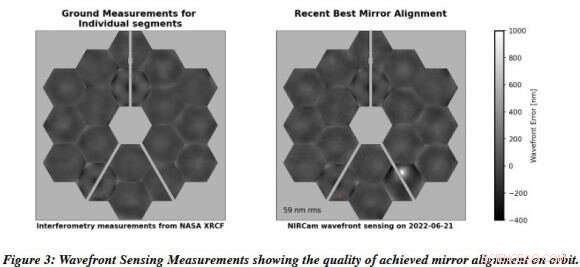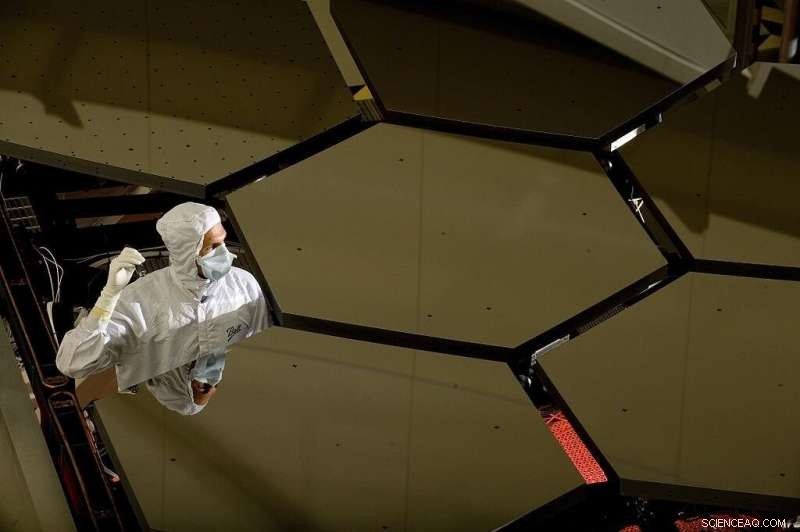
Jämförelse av Webbs spegeljusteringar, hämtade från rapporten "Karakterisering av JWST vetenskapsprestanda från driftsättning" (12 juli 2022). Kredit:NASA/ESA/CSA
Världen rusar fortfarande efter lanseringen av James Webb Space Telescopes (JWST) första bilder. Dessa gav en omfattande översikt över vilken typ av vetenskapsverksamhet som Webb kommer att genomföra under sitt 20-åriga uppdrag. De inkluderade den mest känsliga och detaljerade titten på några ikoniska astronomiska objekt, spektra från en exoplanetatmosfär och en djupfältsvy av några av de mest avlägsna galaxerna i universum. Sedan de släpptes har vi också behandlats med glimtar av objekt i solsystemet som fångats av Webbs infraröda instrument.
Samtidigt släppte JWST-samarbetet en fullständig rapport med titeln "Characterization of JWST science performance from commissioning", där de undersökte allt Webb har åstadkommit hittills och vad de förväntar sig under hela uppdraget. Denna tidning dök nyligen upp online och täcker allt från teleskopets navigering och pekande till prestandan hos dess många instrument. En intressant sak, som inte släppts tidigare, är hur Webb drabbades av en serie mikrometeoroider, varav en orsakade "okorrigerbar förändring" i ett spegelsegment.
Teamet bakom denna studie inkluderade forskare från de tre deltagande rymdorganisationerna - NASA, Europeiska rymdorganisationen (ESA) och den kanadensiska rymdorganisationen (CSA) - och från uppdragets många partnerorganisationer. Dessa inkluderar Space Telescope Science Institute (STScI), Niels Bohr Institute, Max-Planck-Institut für Astronomie (MPIA), UK Astronomy Technology Centre (UK ATC), National Research Council Canada (NRCC), Instituto Nacional de Técnica Aeroespacial (INTA), Centro de Astrobiología (CAB) och många flygbolag, universitet, forskningsinstitut och byråer över hela världen.
Uppsatsen de sammanställde bedömer JWST-prestanda under den sex månader långa driftsättningsperioden innan den togs i bruk den 12 juli 2022. Detta bestod av att karakterisera observatoriets prestanda i omloppsbana, JWST:s design och arkitektur, och prelanseringens förutspådda prestanda. Dessa jämfördes sedan med prestanda för rymdfarkoster, teleskop, vetenskapsinstrument och marksystem. Avsnitt 4 i rapporten, Optisk prestanda, tar upp hur Webbs olika instrument fungerade under driftsättningsperioden.

Ett primärt spegelsegment av rymdteleskopet James Webb, gjord av beryllium. Kredit:NASA/MSFC/David Higginbotham/Emmett Given
JWST:s primära spegel består av arton hexagonala segment arrangerade i en bikakekonfiguration. Varje segment är sammansatt av guldpläterat beryllium, och alla är justerade för att säkerställa högsta möjliga upplösning och känslighet. Den totala prestandan mäts i termer av Wavefront Error (WFE), som hänvisar till hur ljus som samlas in av teleskopets speglar avviker från ljusets förväntade våglängd. Den totala utsträckningen bestäms genom att beräkna det insamlade ljusets avvikelse från Root-Mean-Square (RMS)-felet – det sfäriska medelvärdet av hela vågfronten.
Detta uttrycks matematiskt med hjälp av enheterna för den specifika våglängden, mätt i nanometer (nm) när det handlar om infraröda våglängder. Avsnitt 4.7 tar upp mikrometeoroidpåverkan och deras potentiella effekt på Webbs långsiktiga optiska prestanda. Bedömningen börjar med att påminna läsarna om att alla rymdfarkoster oundvikligen kommer att stöta på mikrometeoroider, och listar sedan hur flera effekter förväntades under driftsättningsperioden:
"Under driftsättningen registrerade vågfrontsavkänning sex lokaliserade ytdeformationer på den primära spegeln som tillskrivs nedslag från mikrometeoroider. Dessa inträffade med en hastighet (ungefär en per månad) som överensstämde med förväntningarna före lanseringen. Varje mikrometeoroid orsakade degradering i vågfronten av impacted mirror segment, as measured during regular wavefront sensing. Some of the resulting wavefront degradation is correctable through regular wavefront control; some of it comprises high spatial frequency terms that cannot be corrected."
They further indicate that these micrometeoroid impacts were detected so far through wavefront sensing. Five of the six detected impacts had negligible effects, contributing to a combined total of less than 1 nanometer to the overall wavefront error. However, the remaining impact, which occurred between May 22nd and May 24th, caused a "significant uncorrectable change" in the overall figure of segment C3. This segment is located on the lower right side of Webb's primary mirror (when seen from the front), and the effect is illustrated in the Report (see image above).
Luckily, the overall effect was small since only a small portion of the telescope area was affected by it. The mission teams also conducted two realignment steps to correct for the impact, which brought the telescope alignment to a minimum of 59 nm RMS, which is about 5 to 10 nm above the previous best wavefront error RMS values. The authors of the Report also go on to note that "drifts and stability levels" in the telescope typically result in a "telescope contribution" of between 60 (minimum) to 80 nm RMS—at which point, wavefront control is typically performed.
They also explain that it is unknown at this time whether or not the May 2022 impact to segment C3 was rare or something that can be expected to happen frequently throughout JWST's mission. As they state, this is essential if the JWST mission teams hope to determine if the telescope will be more susceptible to damage by micrometeoroids than pre-launch modeling predicted:
"The project team is conducting additional investigations into the micrometeoroid population, how impacts affect beryllium mirrors, and the efficacy and efficiency tradeoffs of potential mitigations such as pointing restrictions that would minimize time spent looking in the direction of orbital motion, which statistically has higher micrometeoroid rates and energies."
To summarize, the impact on the C3 segment raised concerns among the mission controllers. But the upside is that it was nothing they couldn't address and is not expected to affect Webb's long-term science operations. As the Report summarizes:
"The key outcome of six months of commissioning is this:JWST is fully capable of achieving the discoveries for which it was built. JWST was envisioned 'to enable fundamental breakthroughs in our understanding of the formation and evolution of galaxies, stars, and planetary systems'… we now know with certainty that it will. The telescope and instrument suite have demonstrated the sensitivity, stability, image quality, and spectral range that are necessary to transform our understanding of the cosmos through observations spanning from near-earth asteroids to the most distant galaxies."
Moreover, the Report's authors conclude that the JWST's performance has been better than expected, almost across the entire board. In terms of the optical alignment of its mirrors, the point spread function, the time-stability of its imaging, and the fine guidance system that points the observatory, Webb has exceeded expectations. They also indicate that the mirrors are cleaner, and the science instruments have generally provided higher total system throughput than pre-launch expectations. All of this adds up to some optimistic appraisals:
"Collectively, these factors translate into substantially better sensitivity for most instrument modes than was assumed in the exposure time calculator for Cycle 1 observation planning, in many cases by tens of percent. In most cases, JWST will go deeper faster than expected. In addition, JWST has enough propellant on board to last at least 20 years."
The JWST Collaboration stated that further details will be presented in a planned series of papers. These will appear in a special issue of the Publications of the Astronomical Society of the Pacific (PASP) dedicated to the JWST. + Utforska vidare